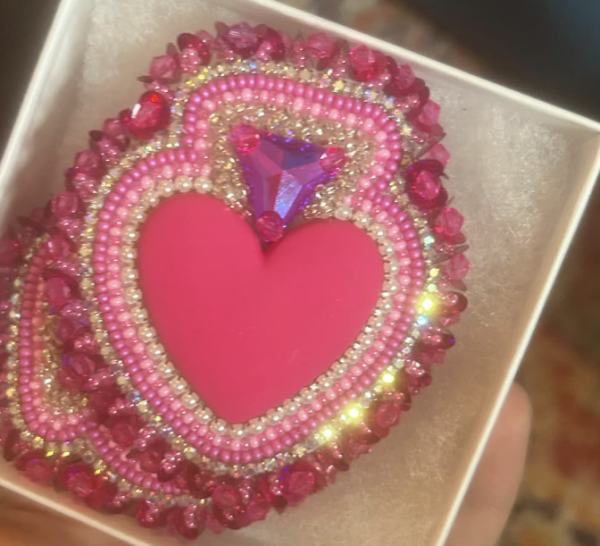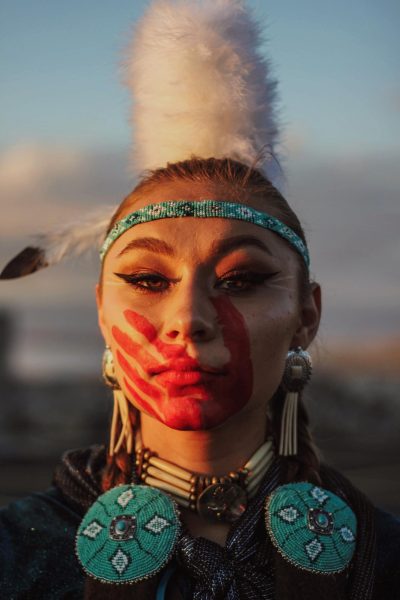
Quinn Caitlin
Junior Noa Stein, Rebecca Stein, and Stephanie Swallow, a dancer.
From March 28–30, Grier students volunteered at the 19th Annual Penn State Powwow, held at the C3 Sports Arena. The event provided a meaningful opportunity for students to participate in and contribute to the celebration of Indigenous culture.

The Penn State Powwow, founded by Professor John Sanchez of Penn State, a member of the Nde (San Carlos Apache) tribe, serves as a powerful way for Indigenous communities to keep ancient traditions alive and share them with others. During the 2023–2024 school year, junior Noa Stein, a member of the Nanticoke Lenni-Lenape tribe, introduced the event to Grier as a volunteer opportunity.
Historically, before colonization, powwows were gatherings that brought different tribes—or different clans within the same tribe—together. These gatherings were often centered around forming relationships and community bonds. “They were traditionally a place where younger individuals would meet partners, because directly within your tribe, you’re going to be related to a lot of those people,” said Stein. “I’m Unami (turtle) Lenape. I could go and meet like Munsee (wolf) Lenape, who I’m not related to, but have similar traditions.”
Today, powwows have evolved into spaces where Indigenous people can both preserve and reclaim their culture. “Today it’s a space where we keep our culture alive. The Penn State Powwow is also called ‘New Faces of Ancient People,’” Stein said. After centuries of forced assimilation—a struggle that continues—powwows offer Indigenous communities a way to protect practices like singing, dancing, and wearing regalia (traditional clothing). They also allow Indigenous people to decide which parts of their culture they want to share with outsiders—something they were historically denied.
“We’re not this sort of stereotype that you’ve put out there of, like, the Indian princess or the noble savage, or these ideas that are entirely colonial on what our race, and what our culture, and what our people are like,” Stein said.

The powwow features a wide variety of tribes, each presenting unique regalia—every piece painstakingly handmade and rich with meaning. For example, jingle dresses are a form of medicine, traditionally practiced by Anishinaabe women. Outfits include a combination of gifted pieces, heirlooms, and expertly crafted designs. Traditional art forms, such as ribbon and bead work are often sold at the event, and all merchandise at the Penn State Powwow is made by Indigenous vendors. These items are appropriate for people of any race to wear respectfully.
That being said, certain practices are closed to non-Indigenous individuals due to their deep cultural and religious significance; similar to how a non-Catholic wouldn’t take part in a Catholic confirmation. The Penn State Powwow is a carefully curated space, allowing Indigenous communities to determine what they choose to share and how they choose to share it.
One particularly emotional moment at the event spotlighted the Missing and Murdered Indigenous Women (MMIW) movement. This movement raises awareness about the staggering rates of violence against Indigenous women in North America. According to the National Criminal Justice Training Center of Fox Valley Technical College, more than four out of five Native women have experienced violence and nearly half have been stalked.

“The National Crime Information Center reports that, in 2016, there were 5,712 reports of missing American Indian and Alaska Native women and girls, though the US Department of Justice’s federal missing persons database, NamUs, only logged 116 cases,” one organization, Native Hope, points out.
A stand entirely dedicated to this issue was covered in red and black, the colors often associated with MMIW. It was created by Littlesnowbird Jones, a member of the Yurok tribe, who delivered a powerful speech beside a red blanket placed on the floor. Nearby was a photo of 14-year-old Emily Pike, an Apache girl and recent victim. While Littlesnowbird discouraged donations, emphasizing that her activism focused on awareness and action instead, the community came together during a “red dress special dance” to offer them anyways, placing them on a red blanket beside the photos of several Indigenous women – all recently reported missing or deceased. All donations were given to the reservation.
For volunteers, the powwow is not just about service—it’s also about meaningful, respectful engagement. Like any volunteering opportunity, it’s a way to support the community, but here, it also offers a chance to learn about and honor Indigenous cultures. Penn State recognizes that it is on Native land —belonging to the Erie, Haudenosaunee (Seneca, Cayuga, Onondaga, Oneida, Mohawk, and Tuscarora), Lenape (Delaware Nation, Delaware Tribe, Stockbridge-Munsee), Monongahela, Shawnee (Absentee, Eastern, and Oklahoma), Susquehannock, and Wahzhazhe (Osage) nations—so, the importance of making space for these communities is especially significant.
Unlike many other U.S. states, Pennsylvania has no reservations today. William Penn historically purchased the land from Native peoples, though the legitimacy of these transactions is debated. The Lenapehoking—“homelands of the Lenape”—spans Pennsylvania, New Jersey, and Delaware, but due to displacement, Lenape descendants now live across the country, with Tribal lands being located in southern New Jersey. Stein herself only recently connected with her tribe, as she lives in Michigan. “We were so far from where our tribe lived originally and where our tribal lands were,” she said.
Ultimately, the powwow is a space where people of all backgrounds can connect with and learn about the cultures that existed on this land long before colonization.
“Powwows are places where we are sharing every aspect of ourselves spiritually. You get to see in an entirely unfiltered way,” Stein said. “What does our singing look like? What does our dancing look like? What does our drum look like? What does our prayer look like? What does our language look like? What does our art look like?”